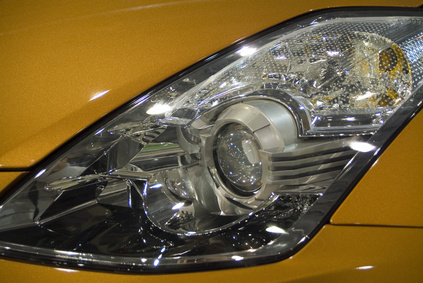
The Nissan 350Z is one of the world's most iconic sports cars and enjoyed strong sales while it was in production between 2002 and 2009. As a result, there are numerous aftermarket performance parts available for the model. As with any modification project, the faster you want to go, the more money you must spend, and the further you will compromise long-term reliability and comfort. While a reasonably handy enthusiast can perform a few of these modifications in his own garage, most of the serious alterations require the help of a professional.
Complete all scheduled maintenance. When you modify your car to go faster, you will place greater stress on every mechanical component. Therefore, you must check the integrity of every part and replace and repair any items that are worn or damaged. Check the oil level and replace the engine oil with a fresh supply. Check your records for when the spark plugs, air filter and brake pads were changed and replace them if they are nearing their useful life. Check the engine for leaks and fix them. Inspect brake lines and all hoses in the engine for tears.
Remove the stock intake unit and install a cold air intake (CAI). This is one of the only modifications that just about any enthusiast can perform by himself. The CAI will help the engine breathe better and lead to a modest power gain. While the improvement at first is not huge, a CAI will help you obtain a greater amount of extra power from future modifications and is also highly affordable. The precise steps you must take, when installing an aftermarket CAI, will depend on the brand since each manufacturer's directions differ.
Install high flow catalytic converters and mufflers in place of the factory units. The exhaust gas has to flow through the catalytic converters and the muffler before it exits the vehicle. The more resistance these parts present, the more of its valuable power the engine must spend to "exhale" instead of turning the wheels. Replacing these factory parts with less restrictive aftermarket units will increase power output. These modifications must be performed by an experienced mechanic unless you have vast knowledge of exhaust systems as well as a full service garage of your own.
Replace the stock headers with long tubes. Headers are the pipes that connect to the exhaust ports of the combustion chambers and lead the spent gases toward the catalytic converters. The same principle as before applies here too: the easier it is for dirty air to flow through this pipe system, the less power the engine must spend to push the air out and the more of that power can go toward moving the vehicle. Long tube headers have been designed to provide less resistance than factory units and will aid in power production.
Reflash the Electronic Control Unit (ECU). The ECU is the computer that controls all of the engine functions to optimize power output. The factory software on your ECU has been calibrated to make the most of factory-installed parts. To maximize the performance of your engine with the new parts you have just installed, you need to download a new program to the ECU. This can be done by a specialized shop which can fine-tune the software based on the exact modifications you have thus far made. The ECU reflash, as this process is often called, will make a significant difference in your car's performance.